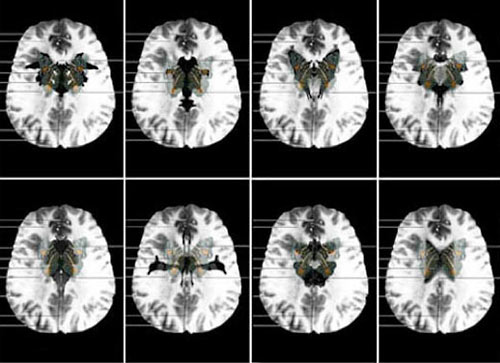The human brain is a truly fascinating topic. It is a part of our bodies that is somewhat elusive and misunderstood, and a society we are constantly learning and discovering new ways in which the brain works. For example, we have come a long way from Ramon y Cajal’s view of the compartmentalized brain - Professor Vesna discussed how Ramon y Cajal thought the brain had 19 separate “organs” that served a specific function, but we now know that many parts of the brain communicate and collaborate in order to function properly. I have a feeling that as long as humans are in existence, we will be constantly discovering new layers of how our brains function and we will never truly know the depth of its capabilities.
Because of our limited understanding of the brain, it is a perfect medium for the subject of art, as many people interpret functions and capacities of the brain in their own ways. I love Suzanne Anker’s artistic Brain Butterflies - this is a perfect example of how science and art have collaborated. Science allows us to take a picture of the brain and view it in a way that we would not be able to see otherwise, and the artwork of combining butterfly images with brain images allows our imagination to run wild about the symbolism of the butterfly within the brain. This seems to coincide with the idea of “neuroaesthetics” - how the conception, execution, and appreciation of visual arts influences our understanding of the brain.
In two of her lectures, Professor Vesna also discusses the powerful influences of the brain with regards to dreams and psychedelic drugs. Both dreams and hallucinogens are powerful mediums for artwork because each person has a separate experience. With both, people seem to be able to escape from reality, or enter an alternate reality. It seems that this escape to an alternate reality is something that people crave and seek out, so people project their ideal alternate realities through their artwork. Additionally, Carl Jung discusses that in order for modern man to fully experience life, he must be fully present and fully conscious. He claims we should direct our attention to the life that we currently experience instead of seeking out an alternate reality. In some ways, our brain allows us to do both. We may experience both the present as well as create our own worlds through our imaginations and express it through artwork.
Sources:
Frazzetto, Giovanni, and Suzanne Anker. "Neuroculture." Nature Reviews Neuroscience Nat Rev Neurosci 10.11 (2009): 815-21. Web.
"The Spiritual Problem of Modern Man." Collected Works of C.G. Jung, Volume 10: Civilization in Transition. Web.
Vesna, Victoria. “Conscious / Memory (Part 1).” Lecture. 16 Nov 2012. <http://www.youtube.com/watch?feature=player_embedded&v=DLVQIwOn7o8>
Vesna, Victoria. Lecture. “Conscious / Memory (Part 2).” 16 Nov 2012. <http://www.youtube.com/watch?feature=player_embedded&v=Xlg5wXHWZNI>
Vesna, Victoria. Lecture. “Conscious / Memory (Part 3).” 16 Nov 2012. <http://www.youtube.com/watch?feature=player_embedded&v=E5EX75xoBJ0>
Images:
http://www.word-nerd.com/images/phrenology.jpg
http://www.dataisnature.com/images/MRI_Butterfly_Suzanne_Anker.jpg
http://wallcoo.net/paint/The_Fantasy_World_of_Josephine_Wall/images/mystical_fantasy_paintings_kb_Wall_Josephine-Psyche%60s_Dream.jpg
Frazzetto, Giovanni, and Suzanne Anker. "Neuroculture." Nature Reviews Neuroscience Nat Rev Neurosci 10.11 (2009): 815-21. Web.
"The Spiritual Problem of Modern Man." Collected Works of C.G. Jung, Volume 10: Civilization in Transition. Web.
Vesna, Victoria. “Conscious / Memory (Part 1).” Lecture. 16 Nov 2012. <http://www.youtube.com/watch?feature=player_embedded&v=DLVQIwOn7o8>
Vesna, Victoria. Lecture. “Conscious / Memory (Part 2).” 16 Nov 2012. <http://www.youtube.com/watch?feature=player_embedded&v=Xlg5wXHWZNI>
Vesna, Victoria. Lecture. “Conscious / Memory (Part 3).” 16 Nov 2012. <http://www.youtube.com/watch?feature=player_embedded&v=E5EX75xoBJ0>
Images:
http://www.word-nerd.com/images/phrenology.jpg
http://www.dataisnature.com/images/MRI_Butterfly_Suzanne_Anker.jpg
http://wallcoo.net/paint/The_Fantasy_World_of_Josephine_Wall/images/mystical_fantasy_paintings_kb_Wall_Josephine-Psyche%60s_Dream.jpg



Your blog this week was very interesting. I also wrote about how drugs affect the brain and the art that is drawn is really unimaginable. Also the artist who sees the butterfly in the brain is different from what I would have thought. As in I would not have seen a butterfly in the brain without you writing about it. Brains are super fascinating.
ReplyDeleteI really like your blog post from this week! I like the pictures you chose. They really add to what you talked about. I agree with you that I don't think there will ever be a day that the human brain is 100% understood. It is truly fascinating!
ReplyDelete